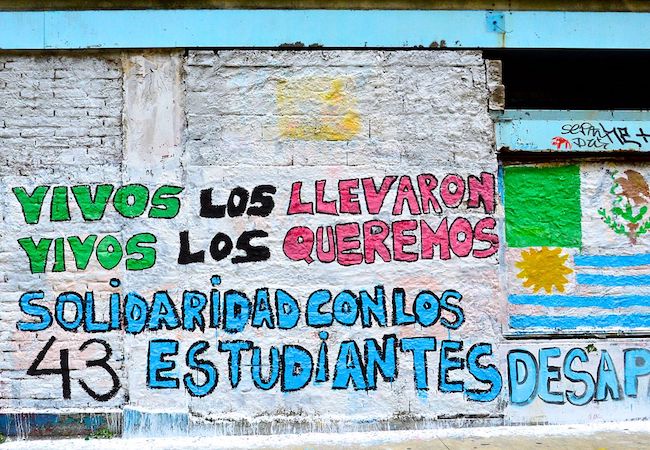
By Liliana Guevara Opinska
September 26th 2017 marks the third anniversary of the forced disappearance of 43 students from the Rural Normal School of Ayotzinapa in the town of Iguala, Guerrero state, Mexico. During the same incident six other people were murdered and forty wounded. There is ample documented evidence implicating directly the local police in the events of that night. There is also evidence that the Mexican state police, the federal police and the military played an active role in the crimes committed. In spite of all this information, three years after, the fate and whereabouts of the 43 students remain unknown.
In fact, there are many discrepancies surrounding the case. According to the official version of the events presented on November 7, 2014 by then-Attorney General, Jesús Murillo Karam, the students were taken by the police in Iguala and later handed over to members of the criminal organization known as “United Warriors”. They were subsequently driven to a landfill in the outskirts of Cocula, where they were murdered and their bodies were burned at the landfill. According to the investigation, the treatment to which the bodies of the students were subject made DNA-identification of the remains impossible.
The Interdisciplinary Group of Independent Experts (GIEI) established as a result of an agreement between the Mexican government and the Inter-American Commission on Human Rights, issued a report in April 2016 documenting numerous flows in the investigation conducted by the government. The GIEI repudiated some of the main conclusions of the investigation presented by the Attorney General’s Office and insisted that the authorities should pursue new lines of investigation.
What does Ayotzinapa mean for Mexico?
Ayotzinapa has become an emblem that, unfortunately, stands for much more than itself. The faces of the 43 students have also become the faces of all those unidentified victims discovered in mass graves in, among others, the states of Guerrero, Nuevo León, Tamaulipas, Coahuila, Durango and Michoacán. Ayotzinapa stands for all the massacres in which the government has been involved either implicitly or explicitly. It stands for the 22 civilians executed by government troops on June 30, 2014 in Tlatlaya, Michoacán. It stands for the massacre in Apatzingán occurred on January 2017, in which the federal police killed 16 civilians and wounded many others. It stands for the Tanhuato shooting on May, 2015, in which the federal police killed 42 alleged gangsters when, in fact, Mexico’s Human Rights Commission has claimed that at least 22 of these killings were extrajudicial.
Ayotzinapa represents the hundreds of thousands of enforced disappearances. The official reports from August 2016 estimate that, since 2006, more than 27,000 people have gone missing. The authorities have done little to nothing to identify and bring to justice those responsible for these disappearances. Ayotzinapa also stands for the widespread military abuses and impunity. From 2006 to July 2016 the National Human Rights Commission (CNDH) received close to 10,000 complains of abuse by the army.
Ayotzinapa means more than one hundred slayed journalists since 2000. It is the face of a country that is considered one of the most dangerous places in the world for journalists. In 2017 alone eleven journalists were murdered in Mexico.
Ayotzinapa encompasses the deeply painful subject of femicides. Although Ciudad Juarez has earned the shameful reputation for being one of the cities with the highest rates of female homicides worldwide, the problem is prevalent across the country. At the time of writing this, September 16 2017, the death of Mara Fernanda Castilla, has been confirmed. Mara went missing after boarding a “Cabify” taxi in the city of Puebla. Mara died of constriction after being sexually abused.
The context for these deplorable human rights abuses is widespread, corruption and impunity. In early November 2014 prominent journalist Carmen Aristegui reported that a favored government contractor was involved in building a multi-million dollar mansion, the “White House”, for the President and his family. Javier Duarte, former Governor of Veracruz, fled Mexico in 2016 after being accused of corruption and money laundering. He was captured in Guatemala, extradited and is currently on trail for siphoning millions of pesos of public funds. Duarte is not the only governor accused of such charges. Recently, the news portal Animal Politico and the association Mexicans Against Corruption and Impunity released the results of an investigation showing that a number of Mexican federal entities were involved in the misappropriation of three billion pesos (~170 millions USD).
The dangers of growing accustomed to violence
In spite of the national and international indignation that began with Ayotzinapa, three years after not much has changed in Mexico, so how do we move forward?
The key to change is a strong civil society. Fortunately, numerous social movements have developed as result of the growing frustration over violence, insecurity, corruption, impunity and the government’s inability to resolve them. These movements include the “Mexican Indignados Movement” led by Javier Sicilia since 2011, “Yo Soy 132” (I Am 132) a students’ movement in opposition to Peña Nieto during his candidacy for president, and the “No More Blood” campaign, among others. The work of independent, critical media is of vital importance in building a well-informed society. The outstanding work of civil associations like “Mexicans Against Corruption and Impunity” must also be highlighted. Most importantly change in Mexico will only be possible through the engagement and participation of the people.
Three years after Ayotzinapa the act of violence persists and it will continue to be present for as long as we do not know the truth. With so much violence happening in Mexico it is easy to look away to avoid pain. However, we must remember that it is precisely when we try to avoid pain by forgetting that we allow for violence to continue. Thus, it is our moral responsibility to not give into apathy, pessimism or resignation. We owe it to the 43 students but perhaps most importantly we also owe it to ourselves.
Liliana Guevara Opinska holds a M.A. in International Relations from the Jagiellonian University in Krakow, Poland and a M.Sc. in Chemistry from the University of Toronto. She is an outspoken advocate for human rights in Mexico and is involved in the organization “We Are All Mexico”, based in Toronto, Canada. Her academic interests include comparative federalism, international trade agreements, energy security, European affairs and human rights in Mexico.




